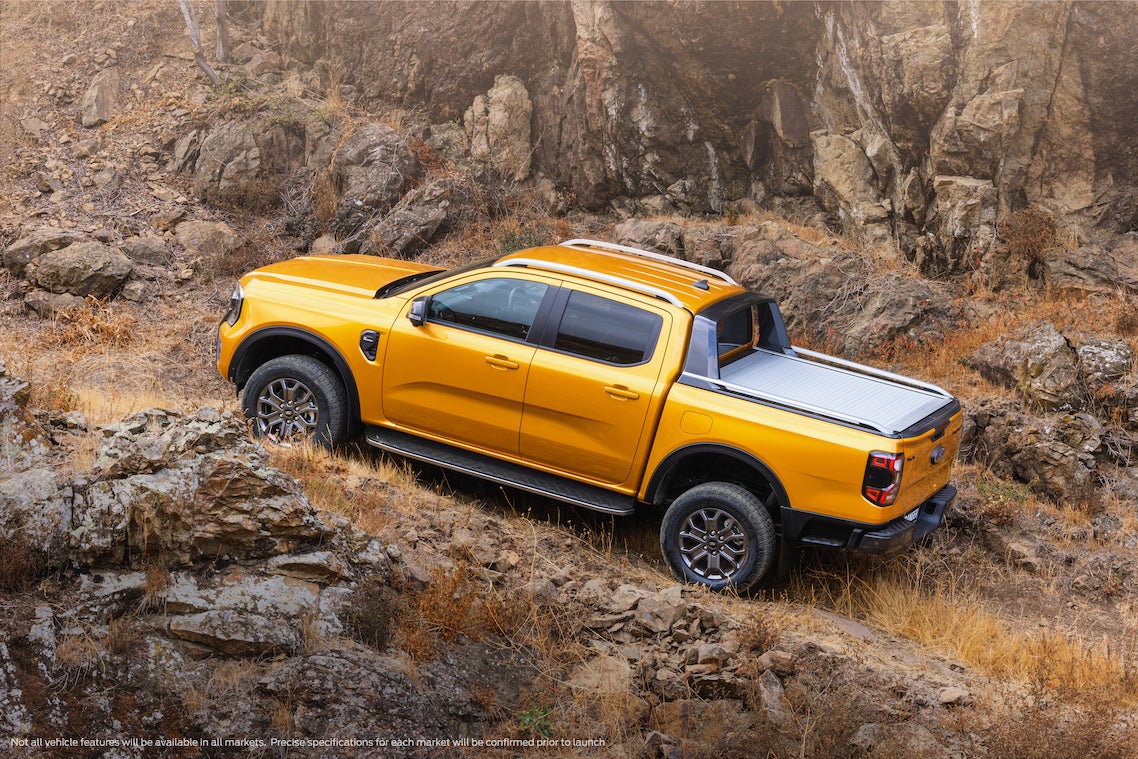
A rain-lashed week of Raptor-driving seems forever ago, intermittent sunshine having been the backdrop for the latest seven days in Ford’s newest pickup. Wishing only for better economy perhaps this one, powered by a four-cylinder engine, might be the perfect Ranger, I wondered?
In contrast to the occasional peculiarity of four seasons in a day, we have a climate devoid of extremes. Which makes these islands less than ideal for testing the off-road credentials of any new 4×4. Even so, I did find deep puddles, mud, loose gravel and bone-dry bitumen in the space of an hour. Thus discovering just how good the new model is in all conditions.
They might be two variants of the same basic vehicle yet in many respects the Wildtrak couldn’t be farther away from the Raptor. That starts with the engines, the thirsty petrol V6 being obviously far more powerful than the 2.0-litre four-cylinder diesel. When it comes to torque though, the tables are turned: 491 Nm versus 500 Nm.
As noted previously, the EC’s latest emissions norms means certain vehicles are now losing significant amounts of oomph, the Raptor being one example. In some countries, outputs are 292 kW (397 PS) and 583 Nm. Which is why the European region’s Wildtrak diesel has more pulling power than a biturbo petrol V6.
In fact, you can go further and order the Wildtrak model grade with Ford’s ‘Lion’ engine, a 3.0-litre V6 which is also available in its VW Amarok twin. This has 179 kW (240 PS) and 600 Nm.
The as-tested four-cylinder diesel has two turbochargers to thank for its 153 kW (205 PS) and 500 Nm. With just the one, numbers are 127 kW (170 PS) and 405 Nm but this engine is reserved for lower trim levels.
Enmeshing powertrains with plants will have required some fairly complicated planning when Ford was developing this, the P703 project. Not to mention the Volkswagen side of things, which sees the blue oval brand not merely sharing technology with its German rival but manufacturing the Amarok too.
With the exception of the Thai-built Raptor, all UK market Rangers come from South Africa. Wayne (Michigan) also came online recently – most of its production is for The Americas – also joined not too long ago by Pacheco (Argentina).
The Wildtrak not only looks the part, it handles well too. And even with a live real axle, comfort is fairly good, helped greatly if there’s any kind of load in the tray. It’s a vehicle you climb up and into, this one, although the stance is lower than that of the Raptor. Which is another reason why the lean in bends isn’t extreme.
There is no mistaking the 2.0-litre engine for anything other than a diesel yet it’s a sophisticated design and that’s reflected in fairly low noise at both idle and under acceleration.
A lot of Rangers are sold as light commercials minus all the snazzy paint, knobbly tyres and other accoutrements but there’s nothing crude or harsh about the vehicle’s basic package. The point here being that passenger versions such as the Wildtrak aren’t that far off the standards of road-holding and comfort anyone who drives an equivalent size SUV takes for granted.
What’s next?
As mentioned in the review of the Raptor, an extended wheelbase body could be on the way for certain countries. This follows a prototype covered in a camouflage wrap having been caught on camera. The LWB Ranger was being tested in Australia.
Until earlier this year, Ford’s worldwide model grades were Wildtrak, Platinum and Raptor. But there have been additions since then, a Wildtrak X variant having been announced in March. This has wider tracks and heavier duty suspension among other features. Ford’s 250 kW and 500 Nm 2.0-litre biturbo diesel engine is standard.
Recently, the company’s national markets in Europe joined Australia and South Africa in announcing the Wildtrak X. There’s a big difference though, power being just 151 kW (205 PS). Torque is at least the same 500 Nm. As with the Raptor, the reduced output is believed to be due to European emissions rules.
Ford of Europe also announced the Ranger Tremor in March. This is based on the XLT but adds the Wildtrak X’s four-wheel drive system and has modified suspension too.
Even though the Ranger is already manufactured in multiple plants, it will also be built in China, Ford stated at the Shanghai motor show in April. The company is still yet to reveal which of its JV partners will be involved in production.
Electrification – PHEV or electric?
The first plug-in hybrid Ranger should be revealed later in 2023 although it isn’t scheduled to go on sale in relevant countries until early 2024. The powertrain will reportedly consist of Ford’s EcoBoost four-cylinder petrol engine and a single motor. Outputs of 270 kW (362 horsepower) and 680 Nm (501 lb ft) are claimed to be the targets.
There might also be an electric variant which would be called Ranger Lightning. That one will likely arrive in 2025, 12-18 months before the entire model line has a mid-life facelift. The next generation is set to debut in 2029-30.
Summary
Ford has really done its homework in terms of making the latest Ranger one of the segment’s best choices. From the range of powertrains, to the ongoing roll-out of ever more tempting variants, it’s no surprise to see this model already becoming a class leader.
The Ford Ranger Wildtrak is priced from GBP40,221.36 (excludes VAT).



